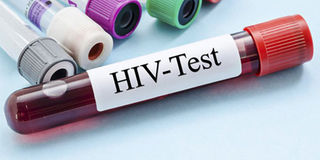Positive gains made in fight against HIV, new data shows

What you need to know:
- The statistical authority estimates that there are 1.4 million adults and children living with HIV/Aids in Tanzania.
New preliminary HIV/Aids prevalence rate data show a 0.4 per cent drop in 2016 compared to 2011/12--a sign that Tanzania is on track in tackling the epidemic.
This is according to statistics by the National Bureau of Statistics (NBS).
The statistical authority estimates that there are 1.4 million adults and children living with HIV/Aids in Tanzania.
However, only slightly over a half of people living with HIV/Aids (52.2 percent) know their status, meaning the remaining are not aware and continue spreading the disease.
The report titled, ‘Tanzania HIV Impact Survey (THIS)’ shows that in 2011/12 prevalence was (5.1 per cent) compared to (4.7 per cent) in 2016. The disease prevalence is higher among women at (6.5 per cent) compared to men (3.5 per cent).
NBS director general Albina Chuwa released the report yesterday during the World Aids Day at an event held at Mnazi Mmoja in the city at the national level and graced by Vice President Samia Suluhu Hassan.
“This is official data from the government. It should be treated as an authority. The Statistics Act is very clear, so I advise politicians not mislead the public by creating their own statistics,” Dr Chuwa warned.
She said the data identified existing gaps in HIV programmes and specific populations that need special focus, adding that new infections remain a major challenge, especially among the youth, and girls in particular, where the prevalence in females is more than twice that of males.
Despite the reported drop, the youth aged between 15 and 24 are more in danger as results showed that prevalence was up by 1.4 per cent compared to adults (0.7 per cent).
The survey was conducted from October 2016 to August 2017 covering a total of 14,811 households.
Furthermore, the prevalence was higher among urban residents by 6 per cent compared to rural dwellers (4.2 per cent).
Lindi and Zanzibar were found to have the lowest prevalence (below 1 per cent) while Njombe (11.6 per cent) and Iringa had the highest.
Speaking as she launched the report, Ms Samia asked men to have some self-respect and stop dating with young girls and instead should let them complete their education.
“There are older men dating with the little ones while knowing that they have been infected with HIV/Aids, this is not right and even God will not forgive them. These are our daughters,” she stressed.
The VP said that the government will continue to collaborate with stakeholders to ensure HIV prevalence was brought down to zero by 2030. She added that various measures have been taken including dissemination of public awareness materials.
Earlier, Health, Community Development, Gender, Elderly and Children deputy minister Faustin Ndugulile revealed that in 2016, out of a total of 196,735 units of blood collected, 5,679 (2.9 per cent) units was found with HIV.
Dr Ndugulile further revealed that in 2016/17 a total of 36.9 million of condoms were sold.



